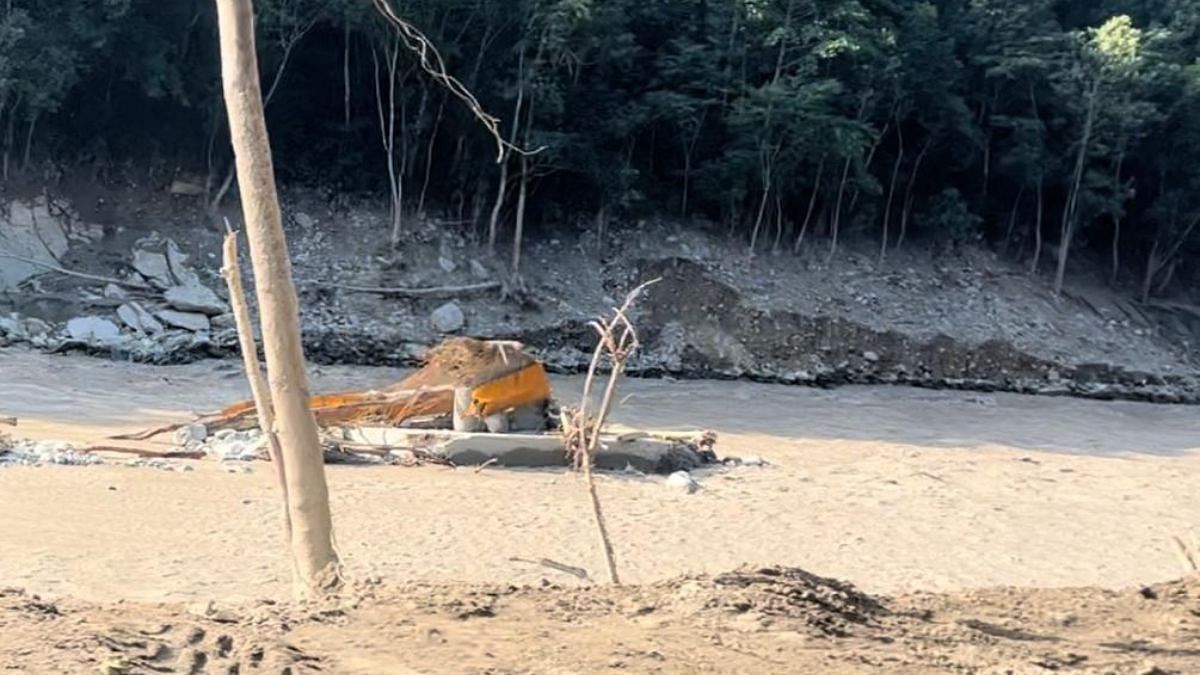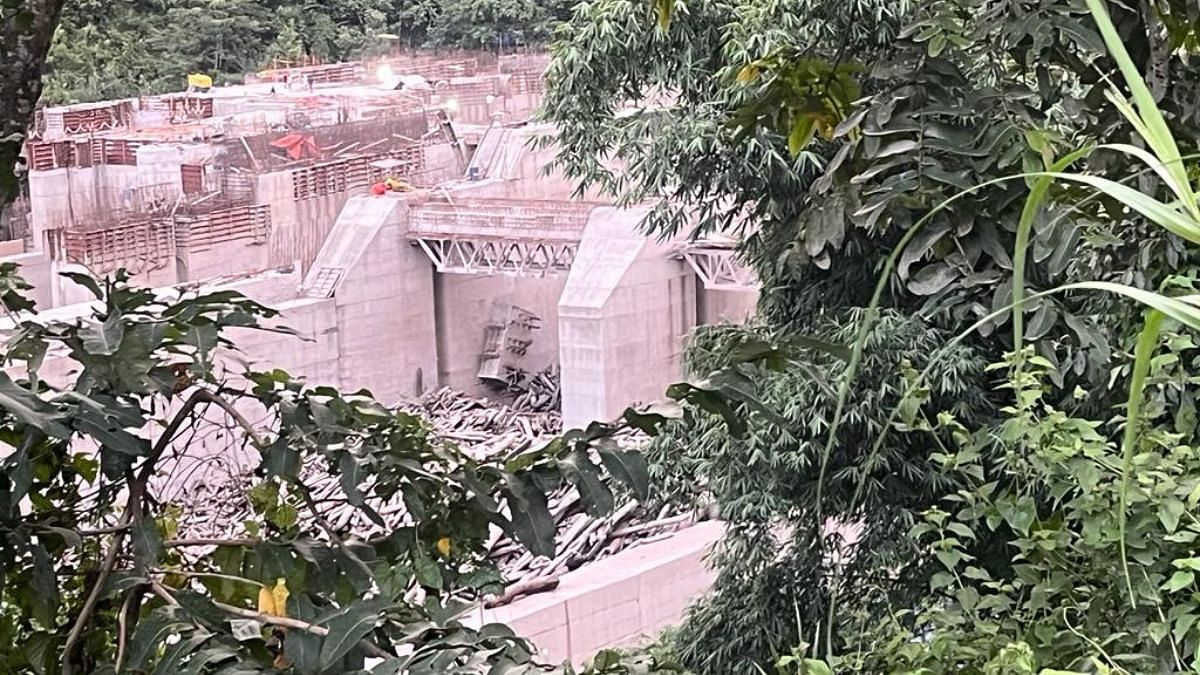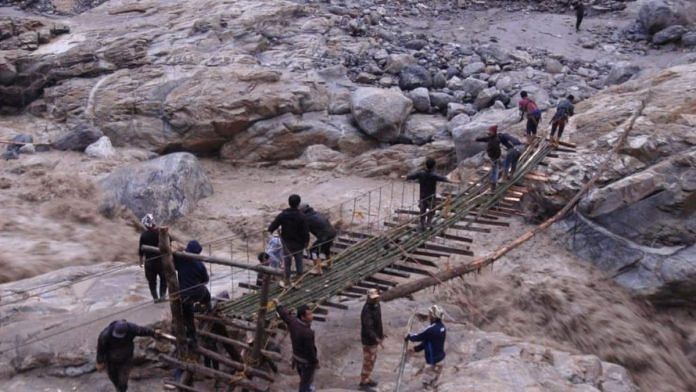Gangtok/Singtam: It was around 10.30 pm on 3 October at Zanak — a remote area at 16,000 feet located around 8 km away from the South Lhonak glacial lake in Sikkim — when an Indo Tibetan Border Police (ITBP) commander on duty first noticed the water level rising suddenly in the nearby narrow Goma chu (meaning river) that joins the Teesta River downstream.
On that cold dark night, even before he could make sense of what was happening, the commander saw the water in the Goma chu rise to approximately 6.5-7 feet, touching the roof of one of the prefabricated huts of the ITBP located around 300 metres from the narrow stream.
He rushed back to inform his commandant who, at 10.40 pm, promptly informed his battalion’s headquarters in capital Gangtok.
Within the next few minutes, the deputy inspector general (DIG) of the ITBP in Gangtok had alerted the administration in Chungthang, a small town in Mangan district of north Sikkim, located at the confluence of Lachen and Lachung rivers that meet to form the mighty Teesta.
By 10.50 pm, the ITBP personnel had raised an alarm in the town. They woke up the Chungthang dam authorities and told them about the possibility of river waters rising to dangerous levels within the next hour or so.
The town bore the maximum brunt of the flood caused by the outburst of the South Lhonak glacial lake on that night, which is reported to have claimed over 80 lives so far. More than 100 people are still missing and several thousands have been displaced.
One of the largest hydropower projects in the state — the 1,200 MW Teesta Stage-III hydropower plant — located in Chungthang, suffered significant damage in the flood with its run-of-the-river dam getting swept away by the huge volume of water discharged from the South Lhonak lake.

Speaking to ThePrint on condition of anonymity, a senior Sikkim government official said that though there is no data to assess the volume of water that got discharged from the South Lhonak lake as of now, in some places it was significantly high.
Between 10.50 pm and 11.00 pm, the ITBP team also asked the Chungthang dam authorities to make arrangements for following all safety protocols. The army and police were also alerted.
“In the next 15-20 minutes (since the alert), some 300 civilians, including dam staff and their family members, women and children, were evacuated and taken to higher locations. We woke up the residents by literally banging down their doors,” an ITBP official told ThePrint.
Sikkim chief secretary V.B. Pathak told ThePrint that ITBP personnel were the first ones to notice the water flow rising in the river as they were the closest to the Lhonak lake. They alerted the administration in no time, he added.
In Gangtok, K. Sanjaykumar, the ITBP DIG, said to ThePrint: “Immediately after getting input on the rise in Goma chu in Zanak, we raised an alarm for all authorities concerned and started evacuating people.”
“We have been conducting rescue operations since 3 October with nine teams (250-300 personnel). Our priority is to save lives and evacuate people to safe locations. Relief camps are being run in all our units. We will provide all support to the state of Sikkim to the best of our capacity and ability,” he added.
Also Read: What turned Teesta into a killer? Here’s proof Sikkim flash floods are a man-made disaster
How dam got swept away
A second senior state government official, who wished to not be named, said that after the ITBP commanders alerted the dam authorities, the latter raised sirens, but by that time water had already risen to the danger level.
“It was then that they (dam authorities) decided to open the dam’s spillway gates. A team of 10-12 dam staff went and tried to open the gates. It was 11.30 pm and the gates could be opened only up to 20-25 per cent. By then, the water had started flowing above the dam,” the official told ThePrint.
Senior officials of the Sikkim government and ITBP confirmed that by 11.40 pm, the dam had started overflowing.
The team that had gone to open the gates drowned, the officials said.
The officials added that the velocity of water was so high that it travelled a distance of approximately 60 km from Zanak, located at 16,000 feet above sea level, to Chungthang, approximately 6,000 feet above sea level, in close to 1 hour and 10 minutes.
“The quantum of water that gushed downstream was also massive. The dam had the capacity to pass through 7,000 cubic metres per second (a unit of rate of flow of water) through its spill gates. But the quantity of water was several times more, because of which the dam could not withstand the pressure and gave way,” one of the state government officials said.
Not only was the quantum of water huge, but its velocity was also extremely high. “It was almost impossible to withstand that kind of force with almost all the five gates closed,” said an official of Sikkim Urja, the company that owns and runs the Rs 13,000 crore Teesta hydropower plant.
A civil engineer in one of the NHPC-run hydropower projects in Sikkim told ThePrint that though the spillway gates are opened through a hydro-mechanical system, it takes between 15 and 20 minutes to open one gate.
“It’s not like you push a button and the gates open. There was very little time to respond. It is possible that had there been an early warning, the Chungthang dam could have been saved and the kind of damage downstream — of both infrastructure and lives — could have been averted,” the second official quoted said.
A third state government official said that the volume of the water increased manifold after reaching Chungthang.
“With the water stored in the dam’s reservoir getting added to the lake and river water, the dam overtopped in no time,” the official said.
The reservoir of the Chungthang dam was holding approximately 5 million cubic metre (mcm) of water.
Aside from the Chungthang dam being swept away, the 1,200 MW power plant has also been damaged in the floods.
“At present, we don’t know the extent of the damage because the power plant has been submerged and large deposits of silt have covered the equipment. There is a lot of expensive equipment inside the plant,” the third official said.
Sunil Saraogi, Chairman and Managing Director of Sikkim Power Investment Corporation Limited (SPICL), told ThePrint that the focus right now is on rescue and rehabilitation.
“That is our priority right now. Some of our officials and staff are missing… Our chief minister has already said that a proper technical investigation will be conducted and the quality of dam construction would be investigated,” he said.
SPICL is the investment company through which the Sikkim government holds a 60 percent stake in Sikkim Urja. The remaining shares are owned by the Hyderabad-based private company Greenko and Power Trading Corporation, a PSU.
Two other hydropower projects also hit
The havoc caused by the South Lhonak lake outburst was not restricted to Chungthang alone.
The ITBP had also alerted the administrations in Singtam and Rangpo, towns located further downstream which also suffered major damage to both infrastructure and lives.
After damaging the dam, water from the lake and Chungthang rivers reached downstream with great force in no time, carrying huge boulders, debris and sediments.
It damaged the five spillway gates of Dikchu dam, part of NHPC’s run-of-the-river 510 MW Teesta hydropower project V at Balutar. Power generation at the plant has been stopped since 4 October. The Teesta V power station and dam, however, remain intact.
“When the water reached the dam at around 1.30 am (4 October), one of the spillway gates was already opened fully while two were partially open. Two other gates could not be opened because of lack of time. At Dikchu, too, the water overtopped the dam. But because one of the gates was open and two partially open, water passed downstream in a slightly controlled way,” an engineer, part of the Teesta-V project, told ThePrint.
The velocity of the water reaching Dikchu was also very high, NHPC officials said, explaining that it generally takes one hour for water to flow from Dikchu dam to Balutar power station, which is 30 km away. But on 4 October, it reached Balutar in 15-20 minutes.
In Dikchu, too, a contractual staff member of the NHPC, who had gone to open the dam gates, was swept away in the flood, according to the officials.
Chitta Ranjan Das, group general manager at Teesta V station, told ThePrint that the concrete gravity dam and the power station at Teesta V had escaped damage.
“The gates of the Teesta-V plant were damaged. Besides, the only cable suspension bridge was damaged and a fire station building, central school, a store and 66 KV substation located in Balutar have been buried under debris. We have started restoration work,” he said.

NHPC officials said the under-construction 500 MW Teesta VI hydropower project in south Sikkim has also suffered damage. “Though no physical structure has been damaged, a huge quantity of silt has covered all the constructed structures and it will take a long time to remove it,” said one official.

NHPC had acquired the Rs 5,780 crore project from private promoter Lanco in 2019 under corporate insolvency resolution process after the latter went bankrupt. The completion deadline of the project is March 2024 but officials said it was “unlikely to meet the target”.
Two hydropower projects becoming inoperational has, however, not impacted the power situation in Sikkim as of now.
“The state’s overall power demand is between 130 MW and 140 MW and it’s being met comfortably from the grid. Sikkim, in fact, exports the surplus power it generates to other states. The shutting down of the two hydro power plants will, however, impact export,” Sikkim chief secretary V.B. Pathak said.
(Edited by Nida Fatima Siddiqui)
Also Read: A burst glacial lake caused Sikkim flood. What’s a GLOF & why Indian subcontinent’s at great risk



